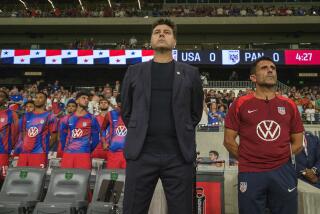Sports Talk : U.S. Finally Gets a Kick at World Cup
In July, 1950, the attention of soccer fans around the world turned to Brazil, where 13 countries competed at the fourth World Cup tournament.
It was a year when the exuberant hosts pulled out the stops to make it the greatest extravaganza of its kind. They even built the 200,000-seat Maracana Stadium in Rio de Janeiro, which remains the largest soccer arena anywhere, specifically for the competition. That’s where they reckoned the national team would be crowned champion.
And it was the year when the United States made its last appearance at one of the quadrennial events.
Things didn’t exactly work out for the Brazilians as they had hoped. Little, unassuming Uruguay shocked them with a 2-1 victory before 199,850--still an attendance record--in the final match. The stunning upset allegedly caused eight deaths from heart attacks in Montevideo, Uruguay’s capital.
That was slightly more dramatic than the uproar caused in Britain a few days earlier by another unlikely result.
In that one at Belo Horizonte, the spunky Americans, sparked by a goal by Haiti-born Larry Gaetjens, blanked all-mighty England, 1-0. The defeat prompted British newspapers to carry black stripes on their front pages.
The victory was the last hurrah for the United States at the Cup. The team lost its other two games in the first round and has never made it out of the regionals since.
That could change soon. For the first time in 40 years, the United States stands a reasonable chance of making it to the World Cup finals. It is down to its last phase of qualifying matches in the CONCACAF (Confederacion Norte, Centroamericana y del Caribe de Futbol) group.
To join the party next year in Italy, the United States needs to finish no worse than second in the five-nation group that includes Costa Rica, Guatemala, Honduras, El Salvador and Trinidad and Tobago. The teams play a round-robin, home-and-away format that will run through most of the year.
Mexico has been the perennial powerhouse of the confederation, but it got caught sending adults to do boys’ work at a junior tournament last year and was kicked off international competition for two years. The suspension turned CONCACAF into a free-for-all.
“I think we have an incredible advantage because Mexico is out,” said Tabares (Tab) Ramos, a Uruguay-born, 22-year-old midfielder who scored the only goal in a 1-0 U.S. victory over Costa Rica on April 30. Ramos, who played for the U.S. Olympic team at Seoul, said, “We have reached a level where we don’t accept anything but a victory.”
Teammate Hugo Perez agrees, but takes a more cautious approach. The 25-year-old forward from El Salvador, a U.S. Olympian in 1984 and a veteran of Major Indoor Soccer League action, knows that overconfidence can be lethal.
“Since Mexico is not playing, all the other teams will play above their heads,” Perez said. “You have to be very careful at all times.”
That’s precisely how Bob Gansler, the U.S. coach, wants his troops to think. Gansler, 47, is a former internationally experienced player and coach. He replaced Lothar Osiander at the helm of the national squad in January.
“Without Mexico you have no favorites. It’s a horse race between the other five. Any of the teams can finish 1-2,” the Hungary-born Gansler said. “We have a realistic chance. It’s a great opportunity for our players to get to Italy, but we cannot get caught up in arrogance and think we have an automatic pass.”
Others believe that the team has graduated from understudy to headliner.
“This is the most competitive team (the United States) has had in many years,” said Peruvian Tony Tirado, the director of sports programming for the New York-based Spanish-language Telemundo television network and a commentator on World Cup matches since 1970.
“They play a European-style game, somewhat mechanical and without the picardia (shrewdness) of the Latin teams, but always playing positively and looking for the opportunities. They create good counterattacks and don’t play as timidly and defensively as before.”
Much of that success has to do with a new breed of more technically sound players. Chief among them are Perez, Ramos, forwards Peter Vermes and Brent Goulet, and midfielder and team captain Rick Davis.
Vermes, 22, plays for Raba ETO in Hungary and is a constant threat to score; Goulet, 24, played last season with a British club and is a former collegiate star at Warner-Pacific College in Portland, Ore., where he scored 108 career goals, and Davis, 30, is an 11-year veteran who has played more international games than any other American player.
“We have evolved as far as our technical ability to play the game,” Gansler said. “There’s much more variety offensively and defensively because the players are better.”
Whether the team has improved enough to make it to Italy next year will be answered Nov. 19 when the Americans travel to Trinidad for their last CONCACAF match.
If the team pulls it off, it would overcome 40 years of frustration in international soccer.






